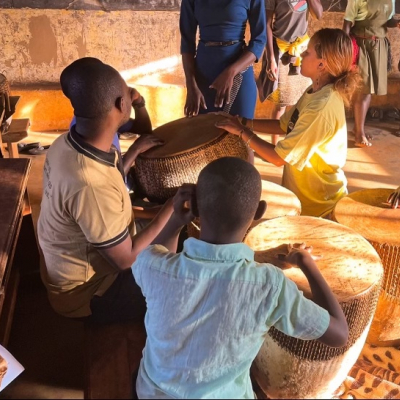Dance Provides a Humanistic Outlook for a Future Neurosurgeon
Margo Lakin, Trinity Communications
Traditionally, the arts and sciences have been viewed as two distant fields of study. But it isn’t uncommon to see Duke students who have defined career dreams in STEM fields (science, technology, engineering and mathematics) also majoring or minoring in the performing and visual arts — adding these disciplines to not only their course loads but also their career goals.
At Duke, Lihua Mo-Hunter (B.S. Neuroscience; minor Dance and Linguistics ’23) has been laser focused on a pre-med track.
She’s found that her coursework in neuroscience has provided more niche topics to study: cellular and molecular neurobiology, effects of marijuana on the brain and even functional neuroanatomy — which allows her to work with brain specimens.

This summer, Mo-Hunter worked with the Duke Global Health Institute (DGHI) Student Research Training program, traveling to Kalangala, Uganda, to study sickle cell disease and to educate the local community.
She received the Benenson Award in the Arts to fund her study of Ugandan dance and music. The award helped her build a creative space for children in the sickle cell clinic, combining music, dance and art to raise awareness and reduce the stigma surrounding the disease.
Recently, Mo-Hunter joined the Swartzwelder Lab, where she plans to work with one of the projects looking at paternal cannabis exposure on the F1 generation (the first generation of offspring produced by a set of parents) of rats while also learning core lab imaging and brain slicing.
“This is important research as it pertains to adolescents. Much of what the lab studies, marijuana and alcohol, is found to have adverse effects on the brain, specifically in the amygdala. Referencing the work coming from the lab, I can give young adults and adolescents specific information that is backed by research.”
While neuroscience, organic chemistry, physics, biology and calculus have taken up most of her time at Duke, she continues to make her Dance Program studies a priority.
For Mo-Hunter, dance began at the age of four with ballet classes. Starting with the American Ballet Theater, she switched studios to focus on Vaganova ballet training, which many will recognize from Russian ballet companies.
Ballet was eventually supplemented by jazz, modern, contemporary and Umfundalai, a contemporary African dance technique combining traditional dance elements with African American–derived rhythms.
“During my Blue Devil Days visit, even before beginning the academic year, I had the opportunity to take a ballet class and fell in love with the Rubenstein Arts Center.”
“I wanted to continue my dance education because I’d committed so much of my life to the art form already and felt that pursuing a minor would be a great option.”
Her approach to dance at Duke has looked at the discipline from an academic standpoint.
“I’ve taken eye-opening courses such as ‘Movement in Question’ and ‘Black Parades,’ which broadened by viewpoint of dance, discussed who is dancing and explored the meaning of different movements.”
Mo-Hunter will be busy this fall, studying both African performance with Professor Ava LaVonne Vinesett and ballet repertory with Associate Professor Iyun Harrison for the Program’s fall performance “November Dances.” And outside of the Dance Program, she’s involved in Duke’s street-style, student dance group Street Medicine.
With your career focused on neuroscience, why is it important to include dance courses in your studies?
Simply put, my dance courses give me a humanistic outlook on people and bodies — and contribute to a diverse and well-rounded education.
My dance courses have allowed me to put more of myself and my experiences into lectures. Rather than the traditional lecture style of sitting and taking notes, I've stood up in the middle of class and moved, created choreography and even taught.
While STEM courses can be very challenging, my Duke dance education is just as challenging and has made me excited to learn in the classroom. Taking dance courses has also allowed me to meet other Duke students who aren’t focused on STEM. If I weren’t in the Dance Program, I wouldn’t be able to interact as much with students across different disciplines.
What does STEM bring to your Dance courses?
My STEM studies have made me immensely diligent and willing to commit time to achieving my goals — long hours in the lab are not uncommon. This diligence and commitment have translated to my work ethic in the dance classroom, in both academics and performance.
I'm not afraid to ask questions or to stay after class for clarification. And I devote long hours to make sure I’m completing my dance-focused requirements properly because of my STEM education.
Have your Dance courses benefitted your STEM studies?
Discipline, attention to detail, learning quickly and maintaining an open mind are skills I’ve developed through dance. From the structure of a ballet class to course material that redefines previous perceptions of a specific style, what I’ve learned in the Dance Program has definitely transferred to my STEM studies.
I see the greatest impact in lab settings: making sure I’m following instructions precisely, rehearsing how I’ll complete something and picking up information quickly are keys to success in dance — and in performing a successful experiment.
My dance courses have also given me a more humanistic outlook on the sciences. I feel STEM can be very “straight to the point,” and more about explaining rather than considering a holistic being. Dance affords me a different lens.
After graduation, what does your next chapter look like?
I plan to attend medical school and eventually specialize in neurosurgery. This has been my dream since a young age, and I’m so grateful that dance has supplemented the pathway to building fine motor skills, attention to detail and quick learning — tools that will inevitably help both during medical school and while in the operating room.